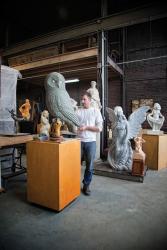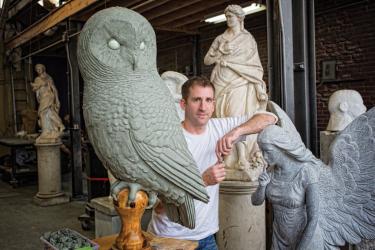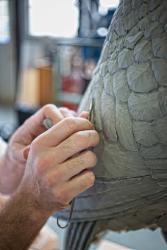“It was Jean Baptiste Carpeaux who pushed me over the edge,” says Abraham Mohler, about his decision long ago to become a sculptor. Mohler attended Arizona State University where he was a walk-on on the baseball team. While there, he took an art history class. When studying Carpeaux, a mid-nineteenth century French sculptor, along with Michelangelo, Bernini and other notable sculptors, he began to love sculptures, especially those made of stone.
“Dropping the baseball bat and picking up the hammer and chisel was a natural progression. Gravitating toward sculpture had a lot to to do with my being an athlete. It is a very physically demanding art—especially sculpting in stone,” he says.
Mohler uses a chisel and hammer, the same tools used by Carpeaux and other sculptors thousands of years ago. However, today he adds modern equipment to his toolbox, such as a pneumatic hammer, which saves wear and tear on the body, and an electric grinder with diamond abrasives, for faster removal of waste.
Mohler's favorite medium is Italian or Portuguese marble. “I love marble because the visual quality is so rich and subtle,” Mohler says. “It has a lot to do with light and shadow. What fascinates me is the way light falls over a form, especially the human form. The question I'm always asking is how does the shape, size and color of the stone respond to the form I'm creating?”
Mohler works in a converted monument shop. It includes a large back doorway for offloading materials, and a giant hoist system to be able to move heavy stones and finished works. Part of the studio includes space for a small gallery. “It's industrial enough that I don't worry about the dust and mess, yet is warm and inviting and easy to sweep up for shows.”
Along with creating, Mohler teaches the art of sculpture. He believes in the atelier-style of education where students apprentice with a master teacher, and currently has several students. He also teaches eight-week classes in sculpting and drawing.
Next year Mohler will install a piece at Mercy Hospital in their memorial garden, but current places to view his work include the Ober Anderson Gallery in Kirkwood and the Missouri Botanical Garden, where his sundial is a permanent piece. He also holds occasional shows at his studio.
Mohler appreciates being able to do art for a living. “What gives me the most pleasure is the lifestyle. Every time I enter my studio I know I've got eight hours to play, to create, to bring a recognizable form out of a lump of material,” he humbly exclaims.
Like many artists, Mohler hopes his art will stand up to the test of time. “I want my art to be viewed in the context of art over the ages,” he explains. “I want it to be compared as much to contemporary art that uses the latest techniques as to the works of a thousand years ago.”









